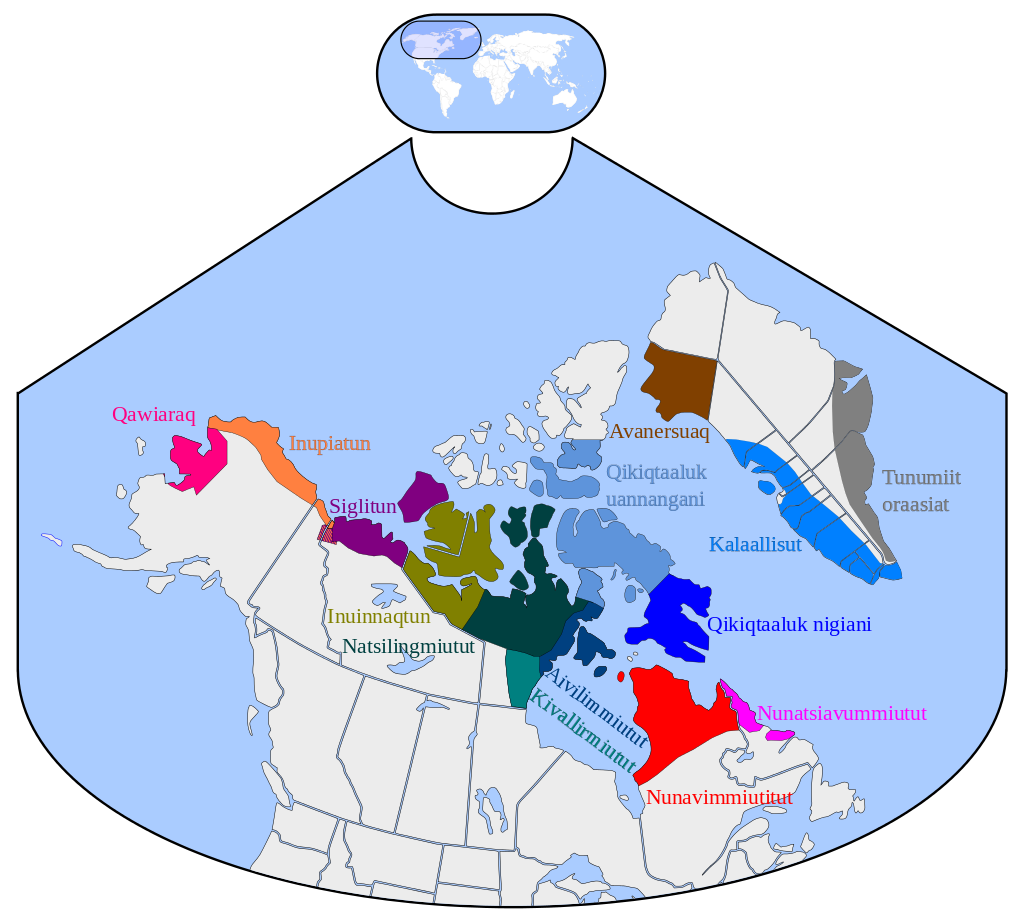Table of Contents
Tunumiisiut in Greenland
Language designations:
Language vitality according to:
Linguistic aspects:
Language standardization
There are different orthographies for Tunumiisiut, and none is set as the standard as Kalaalisut is used for official settings and documents. Though some books exists and offer several orthographies to be used, when Tunimiisut is written in informal settings (social media, text messages, etc), the language is written accroding to personal preferences 1).
Demographics
Language Area
Tunumiisiut is spoken on the east coast of Greenland, in the regions of Ammassalik and Ittoqqortoormiit (in Tunumiisiut) or Illoqqortoormiut (in Kalaallisut) (formerly: Scoresbysund).
Tunumiisiut is indicated as the grey area (Tunumiit Oraasiat) to the East of Greenland on the map below 2), among the other varieties of Inuit in Canada, Greenland and the USA. In Greenland, the main variety of Kalaallisut (West Greenlandic) is shown in blue and and Avenersuaq (North Greenlandic, or Inuktun) is shown in brown.
Map made by Asybaris01, public domain, via Wikimedia Commons.
Speaker numbers
Education of the language
History of language education:
The colonisation and increased autonomy of Greenland has affected the educational system as well as the languages withing the system. The history of formal eductation in Greenland can be divided according to the four historical eras:
1721-1953: Greenland as colony of Denmark
As missionary work were the base for education in Greenland, and reading the Bible was key for them, the first formal schools in Greenland were established with this purpose. In 1928, Danish became a subject at the Greenlandic schools5)
1953-1979: Reforms as integral part of Denmark
After 1953, steadily the Greenlanders gained more autonomy from Denmark and education reforms were implemented. Greenland was given the status of an autonomous province of Denmark, with two members represented (out of 179 members total) in the Danish Parliament, the Folketing. Alongside, Greenland education was formed according to the Danish standards, with the Greenlandic School Act of 1967 almost identical to the Danish public schools. Teachers and administrators from Denmark were hired to implement this system6).
1979- now: Greenland Home Rule Act
This Act defines the autonomy of Greenland as part of the Kingdom of Denmark. The Greenland people are Danish citizen with equal rights. Denmark has jurisdiction over defence, foreign and constitutional affairs, and Greenland has jurisdiction over economic affairs, the social welfare system, tax, cultural and religious affairs and education.
Since the Home Rule Act of 1979, Greenlandic (Kalaallisut) is an official language of Greenland alongside Danish. For education, Greenlandic was made the primary language with the Home Rule Act.7) 8).
2009 - now: Increased Autonomy
After a vote in 2008, the autonomy of Greenland was increased to a self-governing overseas administrative division of Denmark.
Greenlandic (Kalaallisut) is the official language of Greenland since the amendments to the Home Rule Act took effect in June 2009. 9).
- Just as the official language, Greenlandic in education is the Kalaallisut variety of Greenlandic. Tunumiisiut is not covered under formal education, nor is the Avenersuaq/Inuktun variety.
Legislation of language education
International legislation
Denmark has not recognized Greenlandic and its language varieties under the European Charter for Regional or Minority Languages, because the Greenland Home Rule Act gives a high degree of protection already 12)
The same goes for the Framework Convention of the Protection of National Minorities 13).
National legislation
The Greenland Home Rule Act (1978) rules in Chapter 2, Section 9 that:
- Greenlandic shall be the principal language. Danish must be thoroughly taught.
- Either language may be used for official purposes.
However, Kalaallisut is the official Greenlandic variety and therefore, the Home Rule Act does not state any legislation for Tunumiisiut 14).
Local legislation
Within the area, there are no special regulations for Tunumiisiut to be taught at schools besides Greenlandic Kalaallisut15).
Institutional support for education of the language:
There is no institutional support for education of the Tunumiisiut language.
Language learning materials:
Education presence
The language is not taught within formal education, nor used as medium of instruction. Kalaallisut is the main variety taught at schools.
It is not known whether Tunimiisut is taught outside of schools.
Tunumiisiut deals with a low status within Greenland compared to Kalaallisut, which makes the preservation and education of Tunumiisiut more difficult 16)
Online learning resources
- video of the three Greenlandic varieties

